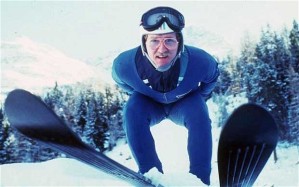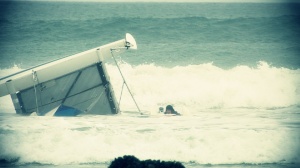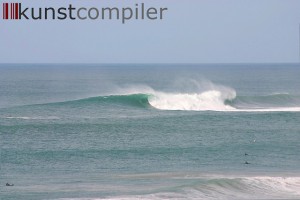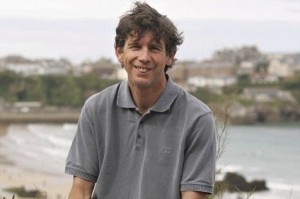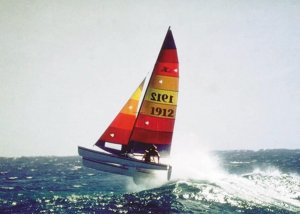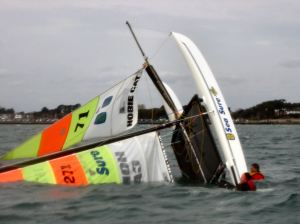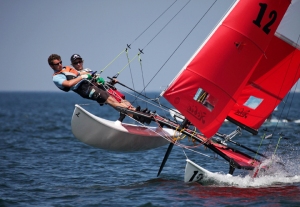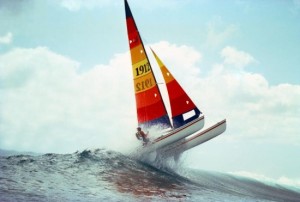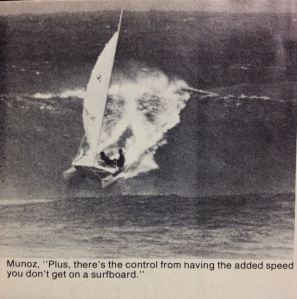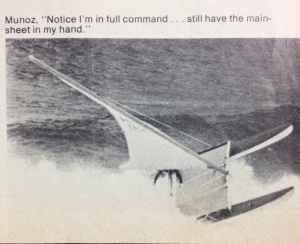Remember Eddie “The Eagle” Edwards the world’s worst ski-jumper? He represented Great Britain at the 1988 Olympics and was terrible, or great, depending on your sense of humour. Naturally he came last in his events. The Eagle risked his life every time he jumped, as did all the other competitors. Eddie was a real British eccentric continuing a fine tradition. Heavily bespectacled “Mr Magoo” the “ski dropper” was taken to heart by the public. Sadly, the humourless authorities changed the rules specifically so The Eagle could no longer compete at the Olympics.
We now have another candidate for crazy, but one who does not receive the empathy given to Eddie The Eagle. Glenn Crawley is popularly known as “Captain Calamity” and widely acknowledged as “The Worlds Worst Sailor”. He sails a Hobie 16 catamaran on the North Cornwall coast at Newquay. Crawley holds the record for having been rescued 15 times (at the last count) by the local RNLI.
It seems he got the catamaran in 2003 and his first 3 rescues in his first 3 months of sailing were because he phoned 999. No details of the circumstances are given, so let us generously assume that he was inexperienced, sailing hard, and got into trouble. He requested a rescue and the RNLI were there to help. Everything at this point was reasonable. The local RNLI were doing what all that funding is given for. Glenn was new to sailing and ran into problems. It happens. The North Cornwall coast is unforgiving and perhaps Glenn Crawley was just unlucky.
Captain Calamity did not get his title by being rescued a few times as an inexperienced sailor in difficult waters. Glenn’s rescues continued over the next decade. In February 2006, he is reported to have been “rescued” 4 times – twice by the RNLI and twice by fishing boats. The 15 RNLI rescues does not count the help Glenn received from local fishermen. Amusingly, Glenn’s 4 rescues occurred in a space of 4 hours! It must have been a challenge for him to get the boat back out to sea in between the rescues. Glenn was trying hard.
In September 2010, Glenn completely wrecked his catamaran which he had amusingly named ‘Mischief’. He managed this by trying to surf Cribbar, also known as The Widow Maker, where the waves can be up to 30 feet high. Thirty feet might not sound much but imagine a breaking wall of water the size of a typical two or three story row of houses bearing down on you. It does not come with a little splash but hundreds of tons of water which can feel like concrete smashing into the boat. Glenn tried surfing this monster on his little plastic cat. The cat did not survive the encounter.
Naturally he got another Hobie cat and called it ‘Going to 11’. His fun continued in the new boat and by 2013 he had notched up his total of 15 RNLI rescues.
The media ran the story to widespread interest. Here is one of the top rated comments from the Daily Mail website:
“Not only are the RNLI volunteers putting their life at risk this stupid man is making them have to take time off work when there is a “shout” and it is all his own fault. There is also the possibility that others could be needing the services of this fine organisation but may have to wait for assistance, and all because of his thoughtlessness and inconsideration for others.”
Almost everyone agrees Glenn Crawley is “Captain Calamity” and “The Worst Sailor in the World”. Case closed?
Brilliant or Stupid?
For my sins, at university I used to try to teach PhD students how to think. There was a useful trick. It did not turn Dr Watson into Sherlock Holmes but it would take him part of the way. The trick is “always-invert”. Theoretical physicists do this sort of thing naturally. It means taking the absolute opposite case. Many people, when it is first explained, think that this is what they do already. You know, they act as devils advocate and look at the issue from the other point of view. They argue the opposite. This is not what I mean.
The idea of always-invert is to be insanely silly and take completely the opposite viewpoint. In this case, we say Glenn Crawley is the Worlds Best Sailor! His sailing is perfect and people should watch him in awe. We pretend Glenn does not need rescuing and the lifeboatmen should watch and learn. In our new crazy world, the local RNLI are not brilliant professionals but halfwits that make Mr Bean look competent. The people rubbishing Glenn are dumb and just parroting what they are supposed to think. Finally, the media are nasty, stupid, and to call them whores would be to give the oldest profession a bad name. No – let’s scrub the last one – even I can’t pretend the tabloid journos are anything but horrible.
Let’s think for ourselves. We will now take the extreme opposite viewpoint and see where it leads. It will be fun and interesting. We’re not really saying Glenn is the Worlds Best Sailor, whatever that means. We don’t know him. We are not defending him. Nor are we attacking the local lifeboat or anyone else. (Well, we might make an exception for the media people.) We are taking an “insane” viewpoint and seeing if we can make it work.
The Hobie 16
Let’s start with the boat. Small sailing dinghies are not stable. Dinghies that are designed to go fast are often really unstable at speed. Most people are familiar with small boats racing and falling on their side in the wind, or even capsizing completely. So we will begin with this in mind.
The Hobie 16 is a famous small fast catamaran. It is one of the most popular boats in the world. This cat is designed to be used from a beach and in the surf. One notable feature is that when moving fast it has a tendency to pitch-pole. The front of one hull digs in and the boat goes end over end coming to rest upside down. Small catamarans do capsize, particularly when sailed hard and the Hobie 16 is no exception. People looking at Glenn from the beach might get the wrong idea that his boat was in trouble when it was doing what it was designed for.
People sailing a Hobie 16, racing in high winds or in surf, are likely to experience occasional capsize. For this reason, a Hobie is designed to be tough and easy to recover. The mast floats and helps sailors right the catamaran. There are other design features in the boat to help sailors right the craft such as lower buoyancy towards the rear of the hulls. It makes it easier for sailors to spin the boat back the right way up. However, even with these features, a solo sailor may have some difficulty righting the boat, particularly in waves. Glenn is not alone or even unusual in repeatedly capsizing his Hobie 16.
People use the Hobie in surf launching from the beach and sailing back up the beach when they return. The rudders detach so they will not be damaged by the sand. For those that need more background here are some Youtube videos of people surfing and capsizing their Hobie cats. I don’t think sailing a Hobie cat like a madman is compulsory, but it is common. It is a small beach catamaran and this is what people do with it.
We can conclude that someone sailing a Hobie catamaran of a North Cornwall beach noted for surfing waves is likely to lift a hull often and have occasional capsizes. An adventurous sailor, or one trying to go fast, is likely to capsize frequently. Racing about and even capsizing a Hobie is not dangerous behaviour in itself but just what sporty sailors do when they want a little action. People often sail them near the shore in big waves at the limits of the boat’s stability. Capsizing a Hobie can be part of the fun.
The dynamic nature of the boat gives a different viewpoint from the one presented in the media. With this dramatic Hobie background, it is difficult to imagine what Glenn could be doing with his boat to attract such unwanted attention. Surfing the Cribbar explains only one occasion.
The Cribbar
People surf their Hobie cats and occasionally take on high winds, wobbly seas, and big waves.
Now let us add images of a surfing Hobie from a 1973 magazine. These old images provide a dramatic context.
That Hobie is doing a great job of surfing a reasonable sized wave. I’m not sure about the size of this Hobie cat but I think it is apparent that this Pacific wave is a similar size to the Cribbar. Waves from 25-35 feet are discussed in the magazine article. The surfers comment that you are better off in the Hobie than on a surfboard. You have so much more authority with the boat compared with a board, apparently.
Sometimes a surfing Hobie can look a little out of control.
Surfing the Cribbar or even moderately sized waves in a catamaran, or anything else, does not appeal to me. Nevertheless, Hobie’s are designed for sailing in surf. Surfing such large waves is not recommended if you want the boat to remain in one piece. Nonetheless, it could be a reasonable activity and relatively safe for an experienced sailor and surfer.
Mr Crawley the Sailor
Reviewing Glenn Crawley’s interviews and comments there was something a little odd. Glenn did not seem ashamed, or even put out, but revelled in his notoriety. Even worse, there seemed to be a hint of humorous disdain about his rescuers and the people dialling 999 because he might be in trouble. Glenn claims he was not in any danger. The boat might be damaged, but he was safe. Perhaps he was oblivious to the risk? Always-inverting we might suggest that perhaps he knew the risks better than the rescuers.
It appears the media and lifeboat have ignored Glenn when he explained that he was a lifeguard for 8-years. His statement does not fit the official story at all. Assuming it is true puts a different take on the situation. It suggests Glenn is an excellent swimmer and has a professional judgement of the risks. Someone in authority found his ability sufficient to look after the lives of swimmers, surfers, and others who might get in harms way.
A lifeguard. Do we really need to be rescuing lifeguards from the surf? If so, who do we send to rescue the lifeguards? Perhaps the story is starting to seem just a little bizarre?
Glenn also claims to taught surfing. Now surfboards topple over, and the surfers are dumped into the water. Windsurfers have similar issues. Similarly, sea kayaks are unstable and capsize. We do not demand that a lifeboat be launched every time a surfer falls off his board, or a sea kayak turns turtle. Let’s be honest, an experienced surfer would soon start to complain about the interference. Surfers are not noted for their shy reticence. Perhaps we should start to focus on the competence of the local lifeboat rather than Glenn Crawley?
Some enterprising students produced an award winning video Glenn Crawley: Being Captain Calamity. Their study takes a more balanced viewpoint than the so-called professional media.
Common Sense?
Whatever happened to common sense? Surely the local RNLI should be aware of what Hobie cats are and what they are used for. They have been informed clearly by Glenn that he does not want to be “rescued” as he is not in danger. Glenn appears to be using his Hobie in the same way as many others sailors. If he needed a rescue, he will call them or signal with flares. Otherwise, Glenn the surf instructor wants to be left alone.
The coast guard or lifeboat could respond to an emergency report by telling the caller that is Glenn Crawley in his Hobie cat. They know him. He used to be a lifeguard. Yes, the boat looks unstable, goes wobbly in the surf, and sometimes it turns upside down. Hobie cats are supposed to do that.
Their current explanation for the multiple “rescues” seems to be that the lifeboat has to respond to every call. In other words the lifeboat’s behaviour is maladaptive. An absolute necessity to respond is both highly doubtful and unproductive. Surely they could exercise some degree of professional judgement? Perhaps they could check it was Glenn and then leave him alone. A lifeboat working blindly to rules so dumb that they leave absolutely no room to adapt – needs better rules! If the lifeboat decides there is a real and present danger, why not just phone Mr Crawley or send someone out to say something like “Hi Glen are you OK? Sorry about bothering you but we had another silly call. If you’re OK we’ll leave you alone.”
The lifeboat should not force a rescue, or even hang about while Glenn is sailing or righting his boat. It is unreasonable for them to inform the media and hold him up to public ridicule. There are names for such behaviour: stalking, harassment, and sociopathy. As Napoleon said – “from the sublime [Penlee lifeboat] to the ridiculous [St Ives Lifeboat] is only a step”. OK, I admit it. Napoleon wasn’t talking about lifeboats.
A Scottish National Treasure
If Glenn Crawley should be prevented from sailing, this Scotsman should be stopped from riding his bike. He breaks all the rules of the road. One mistake and he is dead. He rides on the pavement and over obstacles endangering himself. He ignores the Highway Code. He crashes his machine, falls off, and does dangerous things. He injures himself often. Why are the police not banning him from cycling? Somebody stop him. Quick phone 999. We need Heath and Safety. Now!
Danny MacAskill is a Scottish national treasure and what he does is brilliant performance art.
